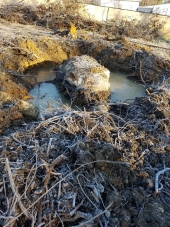
 3
3




Other people may reject you but if you lie in the forest floor for long enough the moss and fungi will accept you as one of their own!
 6
6




 1
1














Jack Edmondson wrote:Forgot to add, the quote from the only place that rented forestry mulcher equipment was $10k per week, 1 week minimum, and a 4 month waiting list to get it. Pick up and delivery was extra and no. I could not pick it up using my own equipment trailer. Needless to say, business must have been very good for them. Hopefully, prices have come down in the past few years. But I decided I would pass and that I was in the wrong business.
Other people may reject you but if you lie in the forest floor for long enough the moss and fungi will accept you as one of their own!
 4
4




 4
4




Some places need to be wild
 2
2










 1
1




Other people may reject you but if you lie in the forest floor for long enough the moss and fungi will accept you as one of their own!
 5
5




 3
3




Invasive plants are Earth's way of insisting we notice her medicines. Stephen Herrod Buhner
Everyone learns what works by learning what doesn't work. Stephen Herrod Buhner
 1
1




At my age, Happy Hour is a nap.




Some places need to be wild






 2
2




Other people may reject you but if you lie in the forest floor for long enough the moss and fungi will accept you as one of their own!
 3
3




Some places need to be wild
 4
4




This is all just my opinion based on a flawed memory







 2
2




Other people may reject you but if you lie in the forest floor for long enough the moss and fungi will accept you as one of their own!






 3
3




Other people may reject you but if you lie in the forest floor for long enough the moss and fungi will accept you as one of their own!
 2
2










 1
1




Other people may reject you but if you lie in the forest floor for long enough the moss and fungi will accept you as one of their own!
 2
2




An eficient way to heat your structures info below
https://permies.com/wiki/63928f371/Wood-Heat-DIY-Rocket-Mass





 2
2


















bruce Fine wrote: pull all the stumps. rent a flap burner for a weekend and burn all the stumps
Other people may reject you but if you lie in the forest floor for long enough the moss and fungi will accept you as one of their own!
 1
1





|
The only thing that kept the leeches off of me was this tiny ad:
Binge on 17 Seasons of Permaculture Design Monkeys!
http://permaculture-design-course.com
|




